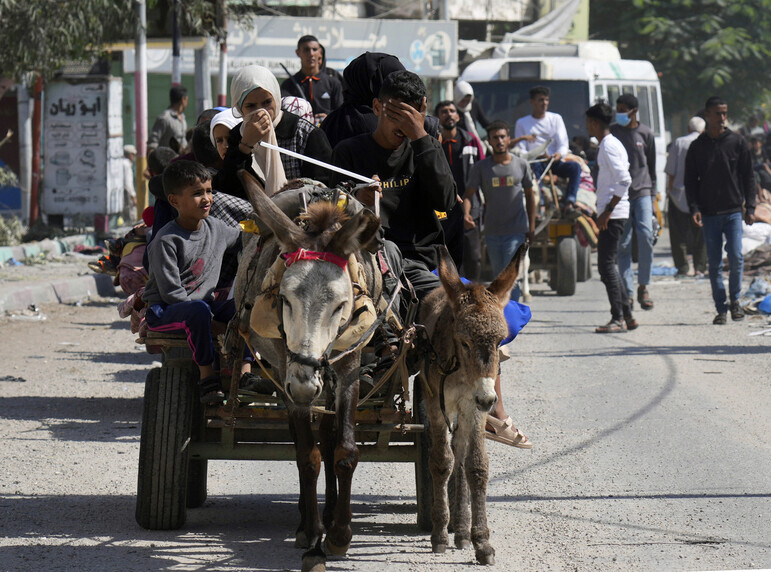hankyoreh
Links to other country sites 다른 나라 사이트 링크
Will 3-war era trigger stagflation for the global economy?

The fear of war is once again back in the global economy. While the war in Ukraine that erupted last February is still ongoing, the armed conflict between Israel and Hamas has cast a black cloud over the already fragile global economy.
Geopolitical risks in the Middle East have always served as flashpoints for the global economy, as conflicts in the region have stoked oil price instability. Moreover, the Israel-Hamas conflict, which comes at a time when the Saudi-led OPEC+ production cuts have kept oil prices around US$90 per barrel, could add fuel to the fire, amplifying fears of inflationary pressures from a spike in oil prices. In other words, stagflation, a combination of soaring prices and recession, could become a reality.
However, contrary to such fears, global stock markets have rallied and oil prices have fallen. While it is too early to assess the situation in the Middle East based on short-term developments, it is worth noting the reasons why financial markets are reacting differently than in the past.
First, the probability that the war will spread is low. While the conflict is likely to become protracted, with Israel preparing for a ground war, the all-out war scenario between major oil producing countries and Israel that financial markets tend to worry about is unlikely to happen.
This suggests that, unlike previous wars in the Middle East, there will be no immediate disruption to oil production in the region and oil transportation through the Strait of Hormuz. The incident has also made it more difficult for OPEC+ to cut production further, which is another factor contributing to the decline in oil prices.
Second, interest rates are falling due to demand for low-risk assets and concerns of an economic slowdown. Since the US Federal Open Market Committee meeting in September, US Treasury yields and other major global government bond yields have fallen sharply, causing financial markets to experience a panic similar to the 2013 tightening.
South Korea also suffered from a hat trick of weaknesses, with stocks, the local currency, and bonds all falling.
As global financial markets were reeling from the rapid rise in interest rates, the risk of war in the Middle East effectively pulled the brakes on the rise in government bond rates. The sharp decline in government bond yields, coupled with global funds’ preference for low-risk assets and concerns of an economic slowdown, acted as a sweetener for global financial markets, including stock markets.
However, the risk of war should not be underestimated. The world is actually experiencing three wars. The Russo-Ukraine war, the Israel-Hamas war, and the US-China power struggle over technological hegemony have exposed the global economy to simultaneous physical and economic shocks. The escalating political conflict in the US ahead of the 2024 presidential election is another risk factor.
The International Monetary Fund forecasts global growth of 2.9% in 2024. Most forecasts for gross domestic product growth in the Group of Seven countries, including the US, are in the 0%-1% range. This is a very unusually low growth forecast.
It would be great if the risks in the Middle East calmed down sooner rather than later, but a prolonged or escalated war in the Middle East on top of the existing conflicts could mean zero growth for the world economy. We should be wary that the world economy could slip into stagflation like in the early 1980s.
By Park Sang-hyun, analyst at Hi Investment & Securities
Please direct questions or comments to [english@hani.co.kr]

Editorial・opinion
![[Editorial] Intensifying US-China rivalry means Seoul must address uncertainty with Beijing sooner than later [Editorial] Intensifying US-China rivalry means Seoul must address uncertainty with Beijing sooner than later](https://flexible.img.hani.co.kr/flexible/normal/500/300/imgdb/original/2024/0517/8117159322045222.jpg) [Editorial] Intensifying US-China rivalry means Seoul must address uncertainty with Beijing sooner than later
[Editorial] Intensifying US-China rivalry means Seoul must address uncertainty with Beijing sooner than later![[Column] When ‘fairness’ means hate and violence [Column] When ‘fairness’ means hate and violence](https://flexible.img.hani.co.kr/flexible/normal/500/300/imgdb/original/2024/0516/7417158465908824.jpg) [Column] When ‘fairness’ means hate and violence
[Column] When ‘fairness’ means hate and violence- [Editorial] Yoon must stop abusing authority to shield himself from investigation
- [Column] US troop withdrawal from Korea could be the Acheson Line all over
- [Column] How to win back readers who’ve turned to YouTube for news
- [Column] Welcome to the president’s pity party
- [Editorial] Korea must respond firmly to Japan’s attempt to usurp Line
- [Editorial] Transfers of prosecutors investigating Korea’s first lady send chilling message
- [Column] Will Seoul’s ties with Moscow really recover on their own?
- [Column] Samsung’s ‘lost decade’ and Lee Jae-yong’s mismatched chopsticks
Most viewed articles
- 1For new generation of Chinese artists, discontent is disobedience
- 2[Editorial] Transfers of prosecutors investigating Korea’s first lady send chilling message
- 3[Exclusive] Unearthed memo suggests Gwangju Uprising missing may have been cremated
- 4[Editorial] Intensifying US-China rivalry means Seoul must address uncertainty with Beijing sooner t
- 5S. Korea “monitoring developments” after report of secret Chinese police station in Seoul
- 6N. Korean media upgrades epithet for leader’s daughter from “beloved” to “respected”
- 7Yoon says concern about biased diplomacy is being incited by “communist totalitarian forces”
- 8[Column] US troop withdrawal from Korea could be the Acheson Line all over
- 9Xi, Putin ‘oppose acts of military intimidation’ against N. Korea by US in joint statement
- 1060% of young Koreans see no need to have kids after marriage